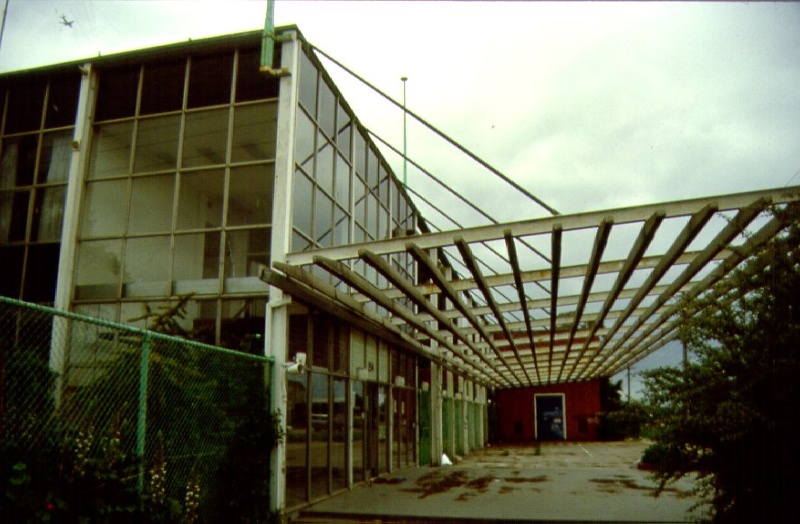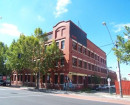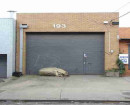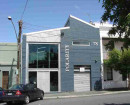ETA FACTORY
254 BALLARAT ROAD BRAYBROOK, MARIBYRNONG CITY
-
Add to tour
You must log in to do that.
-
Share
-
Shortlist place
You must log in to do that.
- Download report




Statement of Significance
The ETA Factory was designed in c1957, and constructed in two stages as the new manufacturing plant for ETA Foods. The building was completed in 1961, and officially opened by the Premier, Henry Bolte, in March 1962. The factory was designed by the architectural partnership Grounds, Romberg and Boyd, and in particular by Frederick Romberg. The ETA Foods company and Marrickville Margarine, which shared the facilities, originated in Sydney in the 1920s and had by the mid 1950s expanded to 9 manufacturing plants and 30 depots throughout Australia, including a small factory in South Melbourne. ETA Foods had been instrumental in the development of the peanut growing industry in Queensland in the 1920s. The ETA brand became a household name of the post-war era.
The new ETA factory was located on a greenfields site on a major arterial road. A basically rectangular form was chosen to serve the close knit functional requirements. It presents to Ballarat Road a long two-storey aluminium curtain wall with horizontal strips of clear glazing and black glass spandrels. There is a regular vertical subdivision of this wall formed by expressed steel columns. The curtain wall is given added dynamism by the diagonal K bracing in every fifth bay, originally highlighted in gold. The bracing works as arrow-like graphic elements leading the eye to the supergraphic ETA sign (no longer extant) at the eastern end of the facade. The curtain wall wraps around one end, and into a courtyard cut into the building, with the clear glazed end of the administration forming the entry. A wide projecting canopy, supported by a steel suspension cables from columns which are an extension of the main building structure, covers the administration wing entrance and the visitor parking area off Lacy Street.
The two largest factory floors are covered by saw-tooth roofs supported by innovative tubular steel trusses. Other spaces include large open span cool stores, smaller specialist manufacturing spaces and a despatch area to the rear. The Ballarat Road garden and the courtyard were landscaped to a design by John Stevens, with only some elements, particularly the sculpture / fountain in the courtyard, remaining.
How is it significant?
The ETA Factory is of architectural, aesthetic and historical significance to the State of Victoria.
Why is it significant?
The ETA Factory is of architectural significance as one of the most successful and distinctive examples of the application of modernist architectural design to a large industrial facility in the 1950s. The ETA factory is of architectural significance an excellent example of the practice of applying a stylish curtain wall, more usually encountered on inner city buildings, to an office and factory complex located on the city outskirts. The design is architecturally significant as a clear expression of the structural rationalism prevalent in Melbourne in the period. The curtain wall facade of the ETA Factory is also architecturally significant for its featurist conception of the facade as billboard.
The ETA factory is of architectural significance as an example of the industrial work of the architectural firm of Grounds, Romberg Boyd, and in particular of Frederick Romberg. The structural expression in the design of ETA factory achieved some international architectural prominence. It was the only Australian design included in the 1962 publication Industriebau, an influential international text on industrial design, published by the German Institute for Industry.
The ETA factory is of aesthetic significance for the landscape design of the courtyard and along Ballarat Road by John Stevens, who also co-designed the modernist garden at ICI House. The ETA Factory gardens are a significant example of the early modernist garden, rare in Australia. The Ballarat Road garden included areas of river pebbles in dramatic zigzag patterns, along with large rocks, cacti and succulents. The courtyard design incorporates an abstract sculpture / fountain by Teisutis (Joe) Zikaris.
The ETA factory is of historical significance as a manifestation of the great surge in construction of manufacturing establishments in the 1950s, mostly in the then outer suburbs, which were part of the economic boom of the post war period. The optimism of the period, and the central position of manufacturing, is reflected in the use of a prominent architect to produce a striking modernist design for the factory headquarters of an Australian company.
-
-
ETA FACTORY - History
CONTEXTUAL HISTORY
During the fifties factory design and construction kept many local architect's offices busy. Melbourne was at this time regarded as Australia's manufacturing capital. On the strength of its primary industry Australia was moving out of its postwar austerity and developing a more prosperous economy. The Government was backing industrialisation all the way in its Post-War re-development pushing for international manufactures to invest in the country and targeting the migrant program toward expanding the workforce.
In Victoria, the State government, to encourage further development, dedicated large tracts of land on the perimeter of the metropolis to industry. Consequently many key manufactures moved from the inner suburbs to build new premises on the city's fringe. General Motors relocated from Fishermen’s Bend to Dandenong in a sleek modern factory designed by Stevenson and Turner. H.J Heinz also relocated to Dandenong abandoning their Richmond site for new premises designed by Hassell and McConnell. Both these new factories were situated on the Princess Highway, a major transport artery with access also to the Gippsland railway. Other key sites for relocation included the Sydney Road which attracted a new Ford Factory and ICI, and the Ballarat Road route, the location of ETA. Of the large number of factory complexes constructed in the period of 1950 - 1960 many were designed by architects.
ETA Foods Pty Ltd and Marrickville Margerine Pty Ltd were founded by the Abel family, Sydney bakers and pastry cooks. Marrickville Margerine was established in 1908 in the Sydney suburb of the same name. Charles Abel and son Albert had visited Europe to investigate the newly established technology of margerine making, with a view to using the product in their business. The factory produced specislised high quality cooking margerines for the baking industry. A large hydrogenation plant was installed in the early 1930s and a wide range of oil products were manufactured for the baking and confectionery industries. The company supplied large quantities of foodstuffs to the armed forces in the Pacific during WWII.
Most of the Australian peanut consumption was imported and there was little interest in peanut growing until 1922 when Marrickville Margarine Company bought the whole Burnett Region (around Kingaroy, Queensland) crop (123 tonnes from 119 hectares). This step boosted the local production and lent a major impetus to the establishment of the peanut industry in Queensland. Albert Abel established ETA foods in 1925.
The Melbourne branch of the company was started by Mr M. P. Stone in 1924. The first company property was bought at Grant St South Melbourne in 1934, and soon extended. ETA was pursuing a policy of Australia wide expansion with each state to be as self supporting in production and supply as possible. By 1961, besides the large Marrickville plant, there was a factrory in Brisbane, a second NSW plant had been opened in Newcastle, and new plants had recently been erected in North Quensland and Adelaide.
HISTORY OF PLACE
ETA Foods moved from a small factory in Grant Street, South Melbourne to new premises, which were built in two stages, in Braybrook. In 1957 ETA Australia was in the process of national expansion. Its Marrickville factory in NSW employed six hundred people and it was busy building new factories in Brisbane and Adelaide as well as developing its Melbourne enterprises.
ETA Foods had originally approached Graeme Lumsden for their new Melbourne premises. Lumsden had designed the very successful Nicholas Factory (unfortunately demolished) whose administration building stood out as one of the notable factory designs of the era. Like ETA, Nicholas used a curtain wall administration block to shield the factory sheds behind. The Nicholas Factory however featured a remarkable porte-cochere entrance; a bold brutalist gesture that was not equalled in any other factory designs including Marsden’s other projects like Smith & Nephew of 1960.
The ETA management had been impressed by the ICI Staff Recreation Centre at Deer Park by Grounds Romberg Boyd (1955), and were also aware of other recently completed works by the practice, such as the Turner and Tip Top Factories, the Sacred Heart Girl's School and the Harris Flats. The old ETA factory at South Melbourne was 25 years old and inefficient because it could not accomodate modern production line layout. The new premises were to be three times bigger with a total area of 800 squares. No margerine was then manufactured in Melbourne and the new factory was to accomodate margerine distribution in addition production of a variety of peanut butter and smaller lines such as chocolates and sugar coated almonds. ETA was to make the production line machinery in its own workshops. The manufacturing area would require good natural lighting and a minimum of columns. The cool stores area was to be self contained.
Early in the design process it was decided that the entire factrory would be contained within a single rectangular envelope, as the various fiunctions were close knit and there was no gain in their being decentralised. The first sketch design was different in a number of ways from the completed product.
The site at Baybrook was essentially a greenfields site as can be seen in an aerial view from Jan 1958. . The first stage including the cool store, margerine store, boiler rooms and chocolate, cherette and sugar almond rooms, was completed in December 1958. This was the largest single unobstructed space coolstore in the state at the time. This area corresponds to the part of the building north of the courtyard with two storey brick walls.The builder was S Haunstrup & Co P/l. There were problems with finalising the contract and arbitration proceedings between the builder and the owners.
Landscape architect John Stevens was approacched to provide a scheme by ETA mid 1960. Interior decor for the offices was designed by R. N. Riddell of Ridell Interiors.
The second stage was built by E. A. Watts competed in 1961 and comprised an additional 60,000 square feet of factory, bulk storage, loading area and parking and the factory itself, which included staff amenities, delivery. The total final area was 81, 850 sq ft, to accommodate 190 workers - 60 in the office, 120 in the factory and 10 travellers and van drivers. The 1 million pound ETA factory was officially opened on by the premier Henry Bolte on Wednesday 15 March 1962. The Herald Sun featured a six page advertising lift out on the factory and ETA's product range.
The ETA Factory was the only Australian design to feature in the 1962 publication Industriebau, a seminal international text on industrial design. Professor Henn from the Institute for Industry, Braunschweig, German wrote to Romberg in 1961 at the recommendation of the architect Gerd Bloch to feature one of his industrial buildings in the folio. ETA was dedicated three pages in the section on food, drink and luxury industries.
Industriebau was translated into Spanish, Italian, French and English. ETA is the only Australian building to feature in the collection and possibly the only industrial Australian design to receive international attention in this era. Dr Henn also requested documents on ETA for the archives to act as a teaching resource for architectural and engineering students at the Institute.
ETA disposed of the factory in ????
The administration offices were used by the Western Regional Commission from ???? to ????ETA FACTORY - Assessment Against Criteria
a. The historical importance, association with or relationship to Victoria's history of the place or object
The ETA Factory is historically important as the most distinctive architect designed factory of the 1950s and 1960s, a period of great expansion in the construction of manufaturing establishments. It is one of the most notable designs by Frederick Romberg, one of Victoria's most celebrated architects of the mid 20th century.
b. The importance of a place or object in demonstrating rarity or uniqueness
c.The place or object's potential to educate, illustrate or provide further scientific investigation in relation to Victoria's cultural heritage
d.The importance of a place or object in exhibiting the principal characteristics or the representative nature of a place or object as part of a class or type of places or objects
e.The importance of the place or object in exhibiting good design or aesthetic characteristics and/or in exhibiting a richness, diversity or unusual integration of features
The ETA Factory is of aesthetic importance for its striking design, particularly the extremely long curtain walled main facade, with its angled bracing and black spandrel panels. The entry canopy is a dramatic cantilever, and forms one side of a landscaped courtyard, and unusual feature for a factory.
f. The importance of the place or object in demonstrating or being associated with scientific or technical innovations or achievements
g.The importance of the place or object in demonstrating social or cultural associations
ETA FACTORY - Permit Exemptions
General Exemptions:
General exemptions apply to all places and objects included in the Victorian Heritage Register (VHR). General exemptions have been designed to allow everyday activities, maintenance and changes to your property, which don’t harm its cultural heritage significance, to proceed without the need to obtain approvals under the Heritage Act 2017.
Places of worship: In some circumstances, you can alter a place of worship to accommodate religious practices without a permit, but you must notify the Executive Director of Heritage Victoria before you start the works or activities at least 20 business days before the works or activities are to commence.
Subdivision/consolidation: Permit exemptions exist for some subdivisions and consolidations. If the subdivision or consolidation is in accordance with a planning permit granted under Part 4 of the Planning and Environment Act 1987 and the application for the planning permit was referred to the Executive Director of Heritage Victoria as a determining referral authority, a permit is not required.
Specific exemptions may also apply to your registered place or object. If applicable, these are listed below. Specific exemptions are tailored to the conservation and management needs of an individual registered place or object and set out works and activities that are exempt from the requirements of a permit. Specific exemptions prevail if they conflict with general exemptions.
Find out more about heritage permit exemptions here.
Specific Exemptions:
General Conditions:
1. All exempted alterations are to be planned and carried out in a manner which prevents damage to the fabric of the registered place or object.
2. Should it become apparent during further inspection or the carrying out of alterations that original or previously hidden or inaccessible details of the place or object are revealed which relate to the significance of the place or object, then the exemption covering such alteration shall cease and the Executive Director shall be notified as soon as possible.
3. If there is a conservation policy and plan approved by the Executive Director, all works shall be in accordance with it.
4. Nothing in this declaration prevents the Executive Director from amending or rescinding all or any of the permit exemptions.
Nothing in this declaration exempts owners or their agents from the responsibility to seek relevant planning or building permits from the responsible authority where applicable.
Exemptions:
* Repairs and maintenance which replace like with like
* Works required for making the buildings safe and protecting them against weather and vandalism, including temporary fencing and closing up of openings.
* Internal additions inside the existing factory, despatch and cool store areas, excluding the administration block to the depth of the courtyard, which do not involve removal of existing fabric or structure, and which do no impact on the Ballarat Road and Lacy Street facades or the facades within the courtyard.
* Reconstruction of the suspended roofing to the visitors parking awning in the same position and the same profile steel sheeting as the original.ETA FACTORY - Permit Exemption Policy
The fabric and spaces which are of the highest architectural significance at the ETA Factory are the Ballarat Road curtain wall, its continuation around the front entrance and along one side of the courtyard, the administration wing interiors, the courtyard and its enclosing walls, and the visitor parking canopy. Any proposed alteration to these elements and spaces should be carefully limited under the permit process.
The rest of the fabric of the factory should be maintained sufficiently to support a proper appreciation of the overall architectural conception. Some alteration is possible in these areas but should be controlled through the pernits process so as to retain the important aspects which support apreciation of the architectural significance of the place. These aspects include include the overall rectangular form of the building, it uniform height, the structural grid , expressed structural features such as the trusses in the factory spaces, and the existing limited palette of materials and finishes. Minor alterations and additions within the factory spaces are subject to a qualified exemption. Appropriate larger scale alterations would be subject to a permit application.
-
-
-
-
-
F.T. Wimble & Co
 Maribyrnong City
Maribyrnong City -
3LO Radio Transmission Station
 Maribyrnong City
Maribyrnong City -
Pilkington ACI
 Maribyrnong City
Maribyrnong City
-
"1890"
 Yarra City
Yarra City -
"AMF Officers" Shed
 Moorabool Shire
Moorabool Shire -
"AQUA PROFONDA" SIGN, FITZROY POOL
 Victorian Heritage Register H1687
Victorian Heritage Register H1687
-
153 Morris Street, Sunshine
 Brimbank City
Brimbank City -
186-188 Smith Street
 Yarra City
Yarra City -
1ST STRATHMORE SCOUT HALL (FORMER)
 Moonee Valley City
Moonee Valley City
-
-














